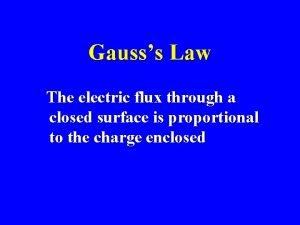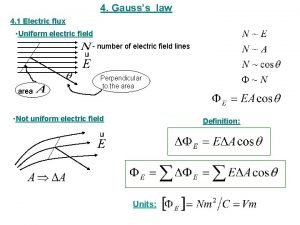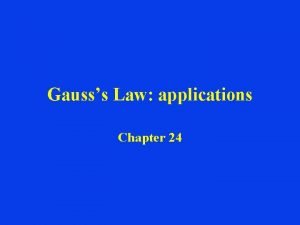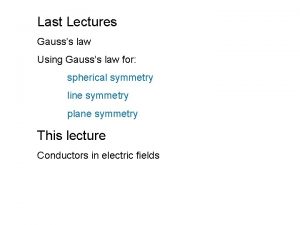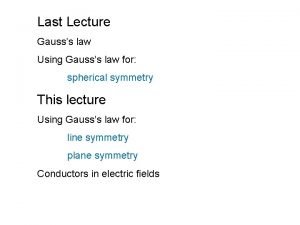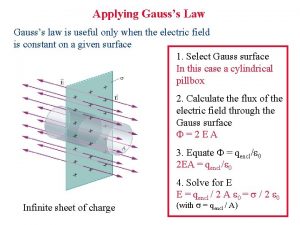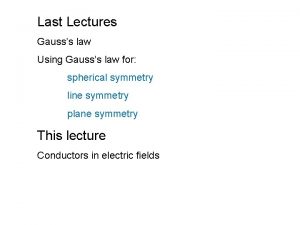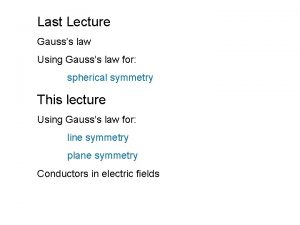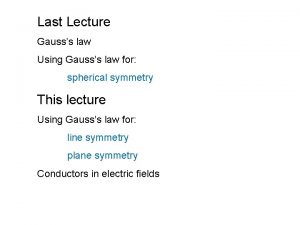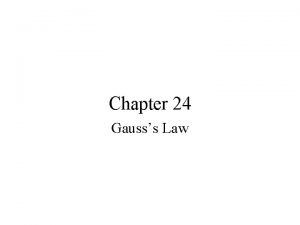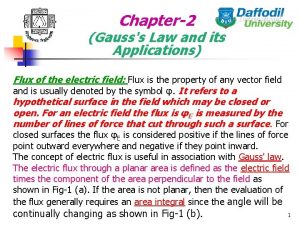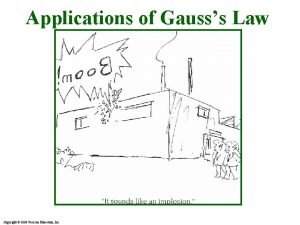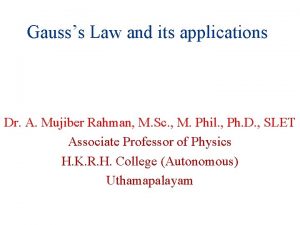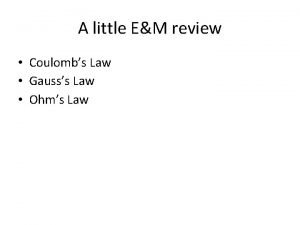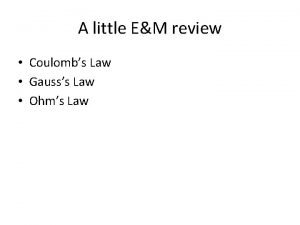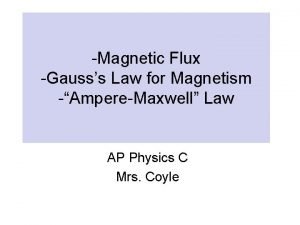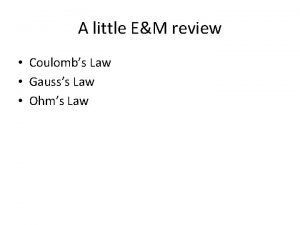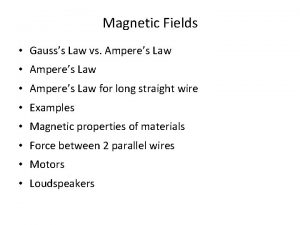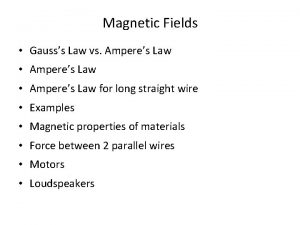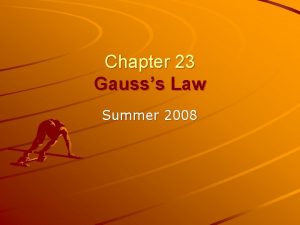Gausss Law applications Chapter 24 Gausss Law The











































- Slides: 43

Gauss’s Law: applications Chapter 24

Gauss’s Law The total flux within a closed surface … … is proportional to the enclosed charge. Gauss’s Law is always true, but is only useful for certain very simple problems with great symmetry.

Applications of Gauss’s Law We are now going to look at various charged objects and use Gauss’s law to find the electric field.

Problem: Sphere of Charge Q A charge Q is uniformly distributed through a sphere of radius R. What is the electric field as a function of r? . Find E at r 1 and r 2. r 1 r 2 R

Problem: Sphere of Charge Q A charge Q is uniformly distributed through a sphere of radius R. What is the electric field as a function of r? . Find E at r 1 and r 2. Use symmetry! r 1 r 2 R

Problem: Sphere of Charge Q A charge Q is uniformly distributed through a sphere of radius R. What is the electric field as a function of r? . Find E at r 1 and r 2. E(r 1) Use symmetry! r 1 E(r 2) r 2 R This is spherically symmetric. That means that E(r) is radially outward, and that all points, at a given radius (|r|=r), have the same magnitude of field.

Problem: Sphere of Charge Q First find E(r) at a point outside the charged sphere. Apply Gauss’s law, using as the Gaussian surface the sphere of radius r pictured. E & d. A What is the enclosed charge? r R

Problem: Sphere of Charge Q First find E(r) at a point outside the charged sphere. Apply Gauss’s law, using as the Gaussian surface the sphere of radius r pictured. E & d. A What is the enclosed charge? Q r R

Problem: Sphere of Charge Q First find E(r) at a point outside the charged sphere. Apply Gauss’s law, using as the Gaussian surface the sphere of radius r pictured. E & d. A What is the enclosed charge? Q r R What is the flux through this surface?

Problem: Sphere of Charge Q First find E(r) at a point outside the charged sphere. Apply Gauss’s law, using as the Gaussian surface the sphere of radius r pictured. E & d. A What is the enclosed charge? Q r R What is the flux through this surface?

Problem: Sphere of Charge Q First find E(r) at a point outside the charged sphere. Apply Gauss’s law, using as the Gaussian surface the sphere of radius r pictured. E & d. A What is the enclosed charge? Q r R What is the flux through this surface? Gauss

Problem: Sphere of Charge Q First find E(r) at a point outside the charged sphere. Apply Gauss’s law, using as the Gaussian surface the sphere of radius r pictured. E & d. A What is the enclosed charge? Q r R Exactly as though all the charge were at the origin! (for r>R) What is the flux through this surface? Gauss: So

Problem: Sphere of Charge Q Next find E(r) at a point inside the sphere. Apply Gauss’s law, using a little sphere of radius r as a Gaussian surface. What is the enclosed charge? That takes a little effort. The little sphere has some fraction of the total charge. What fraction? That’s given by volume ratio: E(r) r Again the flux is: R Setting For r<R gives

Problem: Sphere of Charge Q E(r) R E(r) is proportional to r E(r) is proportional to 1/r 2 for r<R for r>R and E(r) is continuous at R

Problem: Sphere of Charge Q Look closer at these results. The electric field at comes from a sum over the contributions of all the little bits. Q r r>R R It’s obvious that the net E at this point will be horizontal. But the magnitude from each bit is different; and it’s completely not obvious that the magnitude E just depends on the distance from the sphere’s center to the observation point. Doing this as a volume integral would be HARD. Gauss’s law is EASY.

Problem: Infinite charged plane Consider an infinite plane with a constant surface charge density s (which is some number of Coulombs per square meter). What is E at a point a distance z above the plane? y z s x

Problem: Infinite charged plane Consider an infinite plane with a constant surface charge density s (which is some number of Coulombs per square meter). What is E at a point a distance z above the plane? y z s x Use symmetry!

Problem: Infinite charged plane Consider an infinite plane with a constant surface charge density s (which is some number of Coulombs per square meter). What is E at a point a distance z above the plane? y E z s x Use symmetry! The electric field must point straight away from the plane (if s>0). Maybe the magnitude E depends on z, but the direction is fixed. And E is independent of x and y.

Problem: Infinite charged plane So choose a Gaussian surface that is a “pillbox”, which has its top above the plane, and its bottom below the plane, each a distance z from the plane. That way the observation point lies in the top. E Gaussian “pillbox” z z E s

Problem: Infinite charged plane Let the area of the top and bottom be A. E Gaussian “pillbox” z z E s

Problem: Infinite charged plane Let the area of the top and bottom be A. E Gaussian “pillbox” z z E Total charge enclosed by box = s

Problem: Infinite charged plane Let the area of the top and bottom be A. E Gaussian “pillbox” z z E Total charge enclosed by box = As s

Problem: Infinite charged plane Let the area of the top and bottom be A. E Gaussian “pillbox” z z E Outward flux through the top: s

Problem: Infinite charged plane Let the area of the top and bottom be A. E Gaussian “pillbox” z z E Outward flux through the top: EA s

Problem: Infinite charged plane Let the area of the top and bottom be A. E Gaussian “pillbox” z z E Outward flux through the top: EA Outward flux through the bottom: s

Problem: Infinite charged plane Let the area of the top and bottom be A. E Gaussian “pillbox” z z E Outward flux through the top: EA Outward flux through the bottom: EA s

Problem: Infinite charged plane Let the area of the top and bottom be A. E Gaussian “pillbox” z z E Outward flux through the top: EA Outward flux through the bottom: EA Outward flux through the sides: s

Problem: Infinite charged plane Let the area of the top and bottom be A. E Gaussian “pillbox” z z s E Outward flux through the top: EA Outward flux through the bottom: EA Outward flux through the sides: E x (some area) x cos(900) = 0

Problem: Infinite charged plane Let the area of the top and bottom be A. E Gaussian “pillbox” z z s E Outward flux through the top: EA Outward flux through the bottom: EA Outward flux through the sides: E x (some area) x cos(900) = 0 So the total flux is: 2 EA

Problem: Infinite charged plane Let the area of the top and bottom be A. E Gaussian “pillbox” z z s E Gauss’s law then says that As/e 0=2 EA so that E=s/2 e 0, outward. This is constant everywhere in each half-space! Notice that the area A canceled: this is typical!

Problem: Infinite charged plane Imagine doing this with an integral over the charge distribution: break the surface into little bits d. A … d. E s Doing this as a surface integral would be HARD. Gauss’s law is EASY.

Conductors • A conductor is a material in which charges can move relatively freely. • Usually these are metals (Au, Cu, Ag, Al). • In a static condition, the charges placed on a conductor will have moved as far from each other as possible, since they repel each other. • In a static situation, the electric field is zero everywhere inside a conductor. • In a static situation, all the charge resides at the surface of a conductor.

Conductors Why is E=0 inside a conductor?

Conductors Why is E=0 inside a conductor? Conductors are full of free electrons, roughly one per cubic Angstrom. These are free to move. If E is nonzero in some region, then the electrons there feel a force -e. E and start to move.

Conductors Why is E=0 inside a conductor? Conductors are full of free electrons, roughly one per cubic Angstrom. These are free to move. If E is nonzero in some region, then the electrons there feel a force -e. E and start to move. In an electrostatics problem, the electrons adjust their positions until the force on every electron is zero (or else it would move!). That means when equilibrium is reached, E=0 everywhere inside a conductor.

Conductors Because E=0 inside, the inside of a conductor is neutral. Suppose there is an extra charge inside. Gauss’s law for the little spherical surface says there would be a nonzero E nearby. But there can’t be, within a metal! Consequently the interior of a metal is neutral. Any excess charge ends up on the surface.

Problem: Charged coaxial cable This picture is a cross section of an infinitely long line of charge, surrounded by an infinitely long cylindrical conductor. Find E. This represents the line of charge. Say it has a linear charge density of l (some number of C/m). b a Use symmetry! This is the cylindrical conductor. It has inner radius a, and outer radius b. Clearly E points straight out, and its amplitude depends only on r.

Problem: Charged coaxial cable First find E at positions in the space inside the cylinder (r<a). L r Choose as a Gaussian surface: a cylinder of radius r, and length L.

Problem: Charged coaxial cable First find E at positions in the space inside the cylinder (r<a). L r What is the charge enclosed? l. L What is the flux through the end caps? zero (cos 900) What is the flux through the curved face? E x (area) = E(2 pr. L) Total flux = E(2 pr. L) Gauss’s law E(2 pr. L) = l. L/e 0 so E(r) = l/ 2 pre 0

Problem: Charged coaxial cable Now find E at positions within the cylinder (a<r<b). There’s no work to do: within a conductor E=0. Still, we can learn something from Gauss’s law. Make the same kind of cylindrical Gaussian surface. Now the curved side is entirely within the conductor, where E=0; hence the flux is zero. + r Thus the total charge enclosed by this surface must be zero.

Problem: Charged coaxial cable There must be a net charge per unit length -l attracted to the inner surface of the metal, so that the total charge enclosed by this Gaussian surface is zero. - - + - r - -

Problem: Charged coaxial cable There must be a net charge per unit length –l attracted to the inner surface of the metal so that the total charge enclosed by this Gaussian surface is zero. + + + - - + + r + - And since the cylinder is neutral, these negative charges must have come from the outer surface. So the outer surface has a charge density per unit length of +l spread around the outer perimeter. + So what is the field for r>b?

 Conclusion of gauss law
Conclusion of gauss law Gausss law
Gausss law Hát kết hợp bộ gõ cơ thể
Hát kết hợp bộ gõ cơ thể Bổ thể
Bổ thể Tỉ lệ cơ thể trẻ em
Tỉ lệ cơ thể trẻ em Gấu đi như thế nào
Gấu đi như thế nào Thang điểm glasgow
Thang điểm glasgow Hát lên người ơi alleluia
Hát lên người ơi alleluia Các môn thể thao bắt đầu bằng tiếng bóng
Các môn thể thao bắt đầu bằng tiếng bóng Thế nào là hệ số cao nhất
Thế nào là hệ số cao nhất Các châu lục và đại dương trên thế giới
Các châu lục và đại dương trên thế giới Cong thức tính động năng
Cong thức tính động năng Trời xanh đây là của chúng ta thể thơ
Trời xanh đây là của chúng ta thể thơ Cách giải mật thư tọa độ
Cách giải mật thư tọa độ Làm thế nào để 102-1=99
Làm thế nào để 102-1=99 Phản ứng thế ankan
Phản ứng thế ankan Các châu lục và đại dương trên thế giới
Các châu lục và đại dương trên thế giới Thể thơ truyền thống
Thể thơ truyền thống Quá trình desamine hóa có thể tạo ra
Quá trình desamine hóa có thể tạo ra Một số thể thơ truyền thống
Một số thể thơ truyền thống Cái miệng bé xinh thế chỉ nói điều hay thôi
Cái miệng bé xinh thế chỉ nói điều hay thôi Vẽ hình chiếu vuông góc của vật thể sau
Vẽ hình chiếu vuông góc của vật thể sau Biện pháp chống mỏi cơ
Biện pháp chống mỏi cơ đặc điểm cơ thể của người tối cổ
đặc điểm cơ thể của người tối cổ Giọng cùng tên là
Giọng cùng tên là Vẽ hình chiếu đứng bằng cạnh của vật thể
Vẽ hình chiếu đứng bằng cạnh của vật thể Vẽ hình chiếu vuông góc của vật thể sau
Vẽ hình chiếu vuông góc của vật thể sau Thẻ vin
Thẻ vin đại từ thay thế
đại từ thay thế điện thế nghỉ
điện thế nghỉ Tư thế ngồi viết
Tư thế ngồi viết Diễn thế sinh thái là
Diễn thế sinh thái là Dot
Dot Thế nào là số nguyên tố
Thế nào là số nguyên tố Tư thế ngồi viết
Tư thế ngồi viết Lời thề hippocrates
Lời thề hippocrates Thiếu nhi thế giới liên hoan
Thiếu nhi thế giới liên hoan ưu thế lai là gì
ưu thế lai là gì Khi nào hổ con có thể sống độc lập
Khi nào hổ con có thể sống độc lập Sự nuôi và dạy con của hươu
Sự nuôi và dạy con của hươu Sơ đồ cơ thể người
Sơ đồ cơ thể người Từ ngữ thể hiện lòng nhân hậu
Từ ngữ thể hiện lòng nhân hậu Thế nào là mạng điện lắp đặt kiểu nổi
Thế nào là mạng điện lắp đặt kiểu nổi
